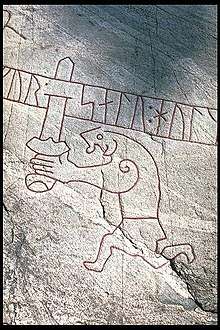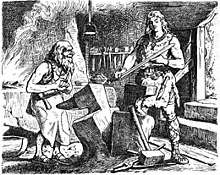Gram (mythology)
In Norse mythology, Gram (Old Norse Gramr, meaning "Wrath")[1] is the sword that Sigurd used to kill the dragon Fafnir.[2] It is primarily used by the Volsungs in the Volsunga Saga. However, it is also seen in other legends, such as the Thidrekssaga wielded by Hildebrand.

Depending on the story and source material, Gram may have other names. In The Nibelungenlied it is named Balmung.[3] In Richard Wagner's work, Der Ring des Nibelungen (The Ring of the Nibelung), it is referred to as Nothung.
Description
Nowhere in the Volsunga Saga is a clear description of Gram given, but there is enough scattered throughout the story to draw a picture of the sword. Sigurd's weapons, Gram included, are described as being "all decked with gold and gleaming bright". [4] Depending on how the text is read, the sword may or may not have a dragon emblazoned on it and/or depending on the translation been "brown of hue".[5]
History
_by_Johannes_Gehrts.jpg)
by Johannes Gehrts (1889)

Gram is primarily seen in the Volsunga Saga used by men in the Volsung line after Sigmund. Sigmund receives it during the wedding feast for his sister, Signy. Part of the way through the feast a strange man appears carrying a sword. Although unknown to Sigmund, this is the god Odin. He thrusts the sword into the Barnstokkr tree that grew in the middle of the hall and said, “The man to pull out this sword from the trunk shall receive it from me as a gift and he will find out for himself that he never bore in hand a better sword than this.” Soon after he departed every man made his attempt to pull the sword out of the wood. All fail except Sigmund who easily extracts it. The sword is a fine sword, and King Siggeir is covetous of it, offering Sigmund three times its weight in gold. When he refuses, King Siggeir grows angry and secretly begins plotting to steal it from Sigmund, eventually killing his father and capturing him and all of his brothers. After this the sword disappears from the narrative until Signy secretly gives it back to Sigmund as he is buried alive with Sinfjotli. After Sigmund avenges his family, he uses the sword in several battles before it is eventually broken by Odin during Sigmund's final battle with the King Lyngvi. Hjördis, Sigmund's wife, takes up the two halves of the blade and keeps them for Sigurd, their son.[6]
After Gram was broken by Odin, Hjördis took the two halves and kept them for her future son. Soon the dwarven smith, Regin, comes and begins teaching Sigurd. After a period of time, he tells Sigurd of the mighty dragon, Fafnir, and the treasure which it guards, asking Sigurd to slay it for him. Sigurd agrees on one condition: that Regin make him a mighty sword capable of slaying such a monster.
Regin confidently makes Sigurd an admirable sword, but when Sigurd sees it, he is disappointed and breaks it over the anvil. On his second attempt, Regin makes him a sword superior to the last, but it also breaks. On his third attempt, Sigurd brings Regin the two halves of Gram, his father's sword, and when he strikes the anvil with Gram, it is cloven in two. Once he tested the strength of the sword, he left the workshop and went to a nearby stream to check its edge. Throwing a piece of wool upstream, he lets it press against Gram, causing it to be sliced through. After testing the blade's sharpness, he uses it to avenge his father, Sigmund, slaying King Lyngvi. Of the many feats done by Gram, by far the most well known and important is the slaying of Fafnir the dragon. This deed is accomplished by Sigurd with a single, mighty thrust to the left shoulder where he drives the sword so deep he gets his arms bloodied up to the shoulder. Eventually Gram is used as a sign of chastity when it is placed between Sigurd and Brynhild on their funeral pyre, after Brynhild arranged Sigurd's death before killing herself in turn. After this the sword is no longer found in the manuscript.[7]
In 'Der Ring des Nibelungen'
In Siegfried, the third of the four operas in the Ring des Nibelungen cycle, Mime, who essentially takes Regin's part, is unable to reforge Nothung (as Gram is called in the Ring). Siegfried, however, manages. Apart from this the story of Regin and Sigurd is more or less identical to that of Mime and Siegfried.
In popular culture
The sword is featured in the 2017 video game Hellblade: Senua's Sacrifice, where it is found and used in combat by the main character, Senua. The sword's origins are explained to the character by her friend Druth, including the story of Sigmund and Sigurd.
Gram is a one-handed sword that appears in the Castlevania series of video games (Symphony of the Night, Aria of Sorrow and Harmony of Despair).
A powerful magical sword named Balmung appears in the video game Myth II: Soulblighter.
Gram is a heavy blade (two-handed sword) in the game Warframe, the sword also has a variant with better attributes called Gram Prime.
Gram (under the name "Nothung") appears in the Cartoon Network animated series Adventure Time as the sword wielded by the legendary hero Billy.
Philosopher Ludwig Wittgenstein refers to Gram (using the name "Nothung") in his work Philosophical Investigations.[8]
Gram is wielded by Siegfried in the Soul Calibur series.
Gram is wielded by Kohri in the game Phantasy Star Online 2.
In Konosuba, Mitsurugi Kyouya was given the 'Cursed Sword Gram' by Aqua and, at one point, used it to slay a dragon.
In the series Highschool DxD, Gram is one of the swords used by a member of the Hero-faction named Siegfried and its ownership was transferred to Kiba Yuuto after Siegfried was defeated.
In the game Fate/Grand Order, Gram is wielded by Sigurd (as a reforged version) and Siegfried (under the name Balmung).
References
- Orchard, Andy (1997). Dictionary of Norse Myth and Legend. Cassell. pp. 59–60. ISBN 0-304-34520-2.
- Sigurd—ein Held des Mittelalters (Edgar Haimerl)
- The Nibelungenlied – A Prose Translation. Project Gutenberg. Translated by Armour, Margaret. London: JM Dent. 1934 [c. 1200]. Retrieved 2019-04-26.
- Vsnrweb-publications. Viking Society Web Publications. Web. Apr.-May 2016.
- Volsunga Saga. Trans. Eirikr Magnusson and William Morris. London: n.p., 1888. N. pag.Sacred-texts. Web. 8 May 2016.
- Vsnrweb-publications. Viking Society Web Publications. Web. Apr.-May 2016.
- Vsnrweb-publications. Viking Society Web Publications. Web. Apr.-May 2016.
- PI §44; ISBN 978-1-4051-5929-6
